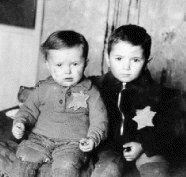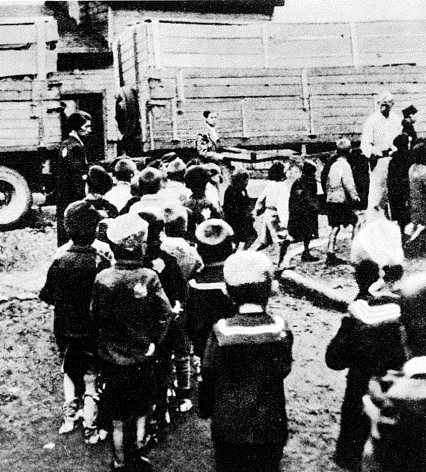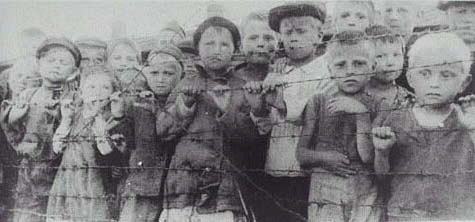"Forget You Not"™
preserving the past to protect the future ...
.
Holocaust Memorial Album
Honoring more than 1.5 Million Souls
under 12 years of age that never returned ...

.Emanuel and
Avram Rosenthal,
killed at Majdanek
Two Hungarian brothers on the
"Death Ramp"
at Birkenau (Auschwitz II),
shortly before they were escorted to
the gas chamber.
![]()
|
|
Jewish Children marching unknowingly to their death ... |
|||
|
|
Cries from Earth to Heaven...
"The first to perish
were the children, abandoned orphans The world's best,
the bleak earth's brightest These children might
have been our comfort From these sad,
mute, bleak faces Our new dawn might
have risen" - From "Song of the Murdered
Jewish People" Whereas
children are usually excited about
attending school, to see friends and join
in socially with classmates, the victims of the
Holocaust, under state authorization,
attended school under deplorable
conditions. As the general public assembled their
prejudice towards the Jewish believers
under the blame placed on them by the Nazi
regime, their attitude
eventually extended into the school
system. The first
noticeable act of an attack on Jewish
students occurred on
April 25, 1933, when the "Law against
Overcrowding in German Schools and
Universities" was put into effect (Daniel's Story).
As
identification and exclusion of Jewish
students became mandatory, attitudes
towards the Jewish children worsened. Like many of
the citizens he fed with his hatred,
Hitler's Propaganda Minister Paul Joseph
Goebbels believed that
"it is unthinkable that my son sit near a
Jew in a German high school" (Tatelbaum).
As a result, public schools began teaching
racial biology, in which the Jewish race
was taught to be inferior to the Germans,
creating an illusion that
they were less than human, and therefore
undeserving of German benefits (United
States Holocaust
Memorial
Museum). Even classmates, who succumbed to
the pounding of brainwashing by
government-endorsed teachers, excluded their
previous Jewish friends from their
company, and turned hostile towards their
old classmates.
Such
treatment in an institution such as
education was extremely painful on the
Jewish children, who themselves began to feel as inferior
as they were treated by their cruel and
commanding instructors and peers. It is
hard today to imagine the ill
will directed towards our innocent youth,
especially in a state sponsored program
like public schools, but the hatred caused
such traumatic feelings in the persecuted
students that as one little girl named
Charlotte stated, she
"won't go to school anymore, no matter
what you say or do" (Tatelbaum). Private
institutions arose as a means of
resistance towards the persecution
pervading public schools, and schools for Jewish
children began after 1933. Under a false
pretense of security, children and
teachers gathered for the instruction they were
denied by the state. However, on October
15, 1936, Germany's Ministry of Science
and Education
declared these private institutions
illegal, closing the doors of opportunity
for an education for many children. Two years
later, on November 15, 1938, Jewish
children were banned from public schools,
and less than a
month
later, from universities (Daniel's Story).
The bitter fact was that "Anti-Semitism...
was the crude reality. It was always present in the
fabric of life" (Leitner). Yet the private
institutions existed long enough for one
purpose. Unknowingly, as
teachers and students attended these
private schools, they were gaining the
background experience that they would use to
run secret schools in ghettos and
concentration camps when education of
Jewish children was declared completely
illegal.
Rachel is
more light than the butterfly, She can not
move her swollen feet, On their
arrival at the ghettos and concentration
camps, notably the Terezin ghetto, the
childrens' usually weak bodies were looked down
upon by the Nazi officials, who demanded
unreasonably strenuous work. Here is where
the most insidious
persecution of the children occurred, the
intentional killing of the youth, and the
heartless overworking
that caused their bodies to fail. In the
packed ghettos, disease spread rapidly
among the close encounters of the inhabitants, and
combined with malnutrition, these horrid
conditions killed thousands of children,
who would not live to see
their adulthood. In the Terezin ghetto,
one of the most notorious for unbearable
conditions, less than 100 out of the 15,000
children inhabitants survived
(Auerbacher). Nearly 1.5 million young
bodies were extinguished, but the children kept
their spirit alive through art, writing,
and inhabiting others memories. Although
the horrid Terezin concentration camp
killed almost 15,000 children, their
memories exist because of a compilation of art and
poetry from the children in the camp. This
compilation, titled "...I Never Saw
Another Butterfly..."
was made by Hana Volavkova and expressed
the emotion felt by the children, and the
inner strength
many
possessed. Franta Bass, a child in the
camp, boldly said "even though I am
suppressed, I will always come back to life." Yet another
determined child declared "I must not lose
faith, I must not lose hope" (Volavkova).
These declarations of
will and determination are extraordinary
when considering the plight these children
faced. Even in the face of death, and in the
midst of slaughter, these children still
spoke out through the power of the pen,
and stayed strong until
the very end, the inevitable death.
Works Cited: "Children in the
Holocaust." Washington, D.C.: United
States Holocaust Memorial Museum 1993. Daniel's Story
Videotape: Teacher Guide. Washington,
D.C.: United States Holocaust Memorial
Museum 1993. Katzenelson,
Yitzhak. "Song of the Murdered Jewish
People." Leitner, Isabella
and Irving A. Leitner. Isabella: From
Auschwitz to Freedom. New York: Doubleday.
1994. Tatelbaum, Itzhak.
Through Our Eyes: Children Witness the
Holocaust. Chicago: I.B.T. Publishing,
1985. Volavkova, Hana, ed.
I Never Saw Another Butterfly: Children's
Drawings and Poems from the Terezin Concentration Camp
1942-1944. New York: Schocken, 1993. Photo
Credit: USHMM
![]()
An
Eulogy
by
Palm Harbor, Florida, USA
![]()
by Yitzhak Katzenelson, murdered with
his son Zvi on May 1, 1944 in the
Auschwitz Camp.Childhood
is a time of innocence, a cloak of
protection under which the future
generation may experience the gifts of life. At this
stage, individuals discover their self,
and formulate the basic attitude and
perception through which they view the
world. Because they comprise the future
generation of humanity and are gaining the
experience they will need
to lead our world, children are the most
prized possession of our population.
However, 1.5 million children experienced a
different form of childhood. They were
stripped from their families, forced to
work in concentration
camps, and eventually murdered during a
period of utmost evil, the Holocaust.
The new
order restricted the Jewish constituent of
the student body to a maximum of 1.5 percent of the total
student body, a clear attempt to filter
the unjustly persecuted Jewish children
out of German sight (United States Holocaust
Memorial Museum). This harsh measure was
only a precursor of stricter orders to
come, and an
escalating prejudice towards Jewish
students.
The mental pain experienced by the
children would only worsen, for after
Kristallnacht in 1938, when Jewish businesses were smashed
and vandalism was supported by the state,
actions against the Jews became
increasingly physical.
Nazi troops
began arresting Jewish men and taking them
to undisclosed locations, leaving the rest
of their families
behind. In some cases, women were also
taken, and children left orphaned, scared,
and confused. If any physical resistance arose
from the Jewish family, they were murdered
in cold blood, sometimes in front of the children's eyes. These
children were prone to haunting memories
of their family being ripped from their
grasp, and in extreme cases,
murdered. The effect of this trauma on the
child's mind was immense, for parents
represent safety
and
stability, and the loss of these
attributes, especially to a young child,
is devastating. Imagine a six year old
girl, hearing the
doorbell, and rushing downstairs to see
her father answer the door. An officer
seizes him, and tells him he must go with them. Her
father fights back, as her mother rushes
to the scene. The Nazi official, drawing
his gun, shoots the
father and drags the mother outside. What
is this young girl, who has just witnessed
the death of a parent and the end of her known
protection, to do? Unfortunately, this
experience happened to many children
during the years of
persecution, producing thousands of
forlorn orphans with an unjustly destroyed
family.
As the
numbers of children left alone increased,
their helpless bodies encountered many
struggles. Illness and starvation in the streets
emaciated the children, and forced them to
beg for food, which was rarely given to
the poor youth merely
because they were Jewish. Yet these
children were soon to face even greater
hardships, as the Nazis began seizing the youth,
and deporting them to concentration camps
and the ghettos, where they stood little
chance at survival.
Children in the
Warsaw Ghetto
RACHEL AND THE
BUTTERFLY
but frozen into the cobble
stone
she will not fly, though it is
a spring.
her palms are like a cobble
stone.
She closes her eyes,
the blue dress is on the
meadow
scattered with marigolds,
the bare feet are in the grass
and a buttterfly is like a
song.![]() And
you can no longer see Rachel
And
you can no longer see Rachel
in the pile of dirty rugs,
she flew away from the ghetto
street.
Yvonna
Opoczynska-Goldberg, 1999.
<zwoje-scrolls.com/shoah/wghetto.html>
The whole world
seemed to be against the innocent children
during the Holocaust, but a few kind souls
aided some fortunate
children. One child, named Stefan Georg
Zweig, was one of these lucky few. Born in
the Cracow ghetto, Stefan
was concealed in a backpack, and
transported secretly through the Plaszow
concentration camp to Buchenwald in 1944, at
the age of only three years old. Upon
arrival, Stefan was cared for by the
communist prisoners of
the Nazis, who compassionately raised the
child and cared for him, allowing this
young soul to survive the war and the Holocaust
(United States Holocaust Memorial Museum).
Such acts of faith were rare, but each one deserves recognition, as
the daring souls who sought to save Jewish
lives were risking their own, and rejected
the popular
attitude of society that living Jews were
wasting German air.
The impact
of the horrible experiences the persecuted
children encountered during the Holocaust
is immeasurable.
Of the few survivors who lived their
childhood through the war years, many were
understandably
emotionally
paralyzed by the trauma, and others cannot
stand to relate the pain of their memories
in words. The child is a precious object, a
clean slate ready to absorb the breath of
life and experience, and a bundle of
potential waiting to be unleashed upon the
world. Yet over a million possessors of
youth were erased from our world, killed
because of their race, and
helpless victims of intense hatred. We
must look at their deaths as witness of
the cruelty hidden in humans, which may be
released if a future Holocaust was to
arise. Only by understanding the potential
of evil in all of us may we prevent another
tragedy. Youth is priceless, and we must
remember the children who were sacrificed
for an evil ideal,
and insure that this ideal stays buried
with time.
![]()
Auerbacher, Inge. I am a Star: Child of
the Holocaust. New York: Prentice-Hall,
1986.![]()
![]()
|
|
|
|
Selected Links:
The Killings of Some 300,000 Children in Treblinka
Australian
Memories of the Children of the
Holocaust
A
Poem To the Little Polish Boy Standing With His Arms
Up
|
|
||||||||||||||||||
|
|
||||||||||||||||||
|
.<emilieschindler.com/Children> The Children Of Izieu, France Eleven-year-old
Liliane Gerenstein, born January 13, 1933 in Nice,
France,
|
||||||||||||||||||
|
|
||||||||||||||||||
. |
||||||||||||||||||

